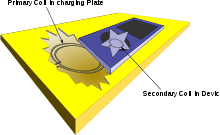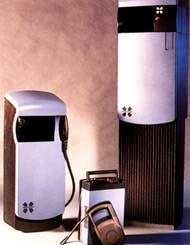Inductive charging


Inductive charging (also known as wireless charging) uses an electromagnetic field to transfer energy between two objects through electromagnetic induction. This is usually done with a charging station. Energy is sent through an inductive coupling to an electrical device, which can then use that energy to charge batteries or run the device.
Induction chargers use an induction coil to create an alternating electromagnetic field from within a charging base, and a second induction coil in the portable device takes power from the electromagnetic field and converts it back into electric current to charge the battery. The two induction coils in proximity combine to form an electrical transformer.[1][2] Greater distances between sender and receiver coils can be achieved when the inductive charging system uses resonant inductive coupling. Recent improvements to this resonant system include using a movable transmission coil (i.e. mounted on an elevating platform or arm) and the use of other materials for the receiver coil made of silver plated copper or sometimes aluminium to minimize weight and decrease resistance due to the skin effect.
Advantages
- Protected connections – No corrosion when the electronics are all enclosed, away from water or oxygen in the atmosphere. Less risk of electrical faults such as short circuit due to insulation failure, especially where connections are made or broken frequently.
- Low infection risk – For embedded medical devices, transmission of power via a magnetic field passing through the skin avoids the infection risks associated with wires penetrating the skin.
- Durability – Without the need to constantly plug and unplug the device, there is significantly less wear and tear on the socket of the device and the attaching cable.
- Increased convenience and aesthetic quality – No need for cables
Disadvantages
- Slower charging – Due to the lower efficiency, devices take longer to charge when supplied power is the same amount.
- More expensive – Inductive charging also requires drive electronics and coils in both device and charger, increasing the complexity and cost of manufacturing.[1][2]
- Inconvenience - When a mobile device is connected to a cable, it can be freely moved around and operated while charging. In most implementations of inductive charging, the mobile device must be left on a pad to charge, and thus can't be moved around or easily operated while charging.
Newer approaches reduce transfer losses through the use of ultra thin coils, higher frequencies, and optimized drive electronics. This results in more efficient and compact chargers and receivers, facilitating their integration into mobile devices or batteries with minimal changes required.[3][4] These technologies provide charging times comparable to wired approaches, and they are rapidly finding their way into mobile devices.
For example, the Magne Charge vehicle recharger system employs high-frequency induction to deliver high power at an efficiency of 86% (6.6 kW power delivery from a 7.68 kW power draw).[5]
Standards
- Magne Charge, a largely obsolete inductive charging system, also known as J1773, used to charge battery electric vehicles (BEV) formerly made by General Motors.
- Qi, an interface standard developed by the Wireless Power Consortium for inductive electrical power transfer.
- In January 2012, the IEEE announced the initiation of the Power Matters Alliance (PMA) under the IEEE Standards Association (IEEE-SA) Industry Connections. The alliance is formed to publish set of standards for inductive power that are safe and energy efficient, and have smart power management. The PMA will also focus on the creation of an inductive power ecosystem[6]
- Rezence was an interface standard developed by the Alliance for Wireless Power (A4WP). A4WP and PMA merged in 2015.
Examples
Portable electronics and devices
- Oral-B rechargeable toothbrushes by the Braun company have used inductive charging since the early 1990s.
- At the Consumer Electronics Show (CES) in January 2007, Visteon unveiled their inductive charging system for in vehicle use that could charge only specially made cell phones to MP3 players with compatible receivers.[7]
- April 28, 2009: An Energizer inductive charging station for the Wii remote was reported on IGN.[8]
- At CES in January 2009, Palm, Inc. announced their new Pre smartphone would be available with an optional inductive charger accessory, the "Touchstone". The charger came with a required special backplate that became standard on the subsequent Pre Plus model announced at CES 2010. This was also featured on later Pixi, Pixi Plus, and Veer 4G smartphones. Upon launch in 2011, the ill-fated HP Touchpad tablet (after HP's acquisition of Palm Inc.) had a built in touchstone coil that doubled as an antenna for their NFC-like Touch to Share feature .[3][9][10]
- March 15, 2013 Samsung launched the Samsung Galaxy S4, which supports inductive charging with an accessory back.
- July 26, 2013 Google and ASUS launched the Nexus 7 2013 Edition with integrated inductive charging.
- September 9, 2014 Apple announced Apple Watch (released on April 24, 2015), which uses wireless inductive charging.
- Qi devices
- Nokia launched two smartphones (the Lumia 820 and Lumia 920) on 5 September 2012, which feature Qi inductive charging.[11]
- Google and LG launched the Nexus 4 in October 2012 which supports inductive charging using the Qi standard.
- Motorola Mobility launched their Droid 3 and Droid 4, both optionally support the Qi standard.
- On November 21, 2012 HTC launched the Droid DNA, which also supports the Qi standard.
- October 31, 2013 Google and LG launched the Nexus 5, which supports inductive charging with Qi.
- April 14, 2014 Samsung made the Galaxy s5 that supports Qi wireless charging with either a wireless charging back or receiver.
- November 20, 2015 Microsoft launched the Lumia 950 XL and Lumia 950 which support charging with the Qi standard.
- Dual standard
- March 3, 2015 Samsung announced the new flagships S6 & S6 Edge with wireless inductive charging through both Qi and PMA compatible chargers.
- November 6, 2015 BlackBerry released the new flagship BlackBerry Priv, the first BlackBerry phone to support wireless inductive charging through both Qi and PMA compatible chargers.
Transportation
- Hughes Electronics developed the Magne Charge interface for General Motors. The General Motors EV1 electric car was charged by inserting an inductive charging paddle into a receptacle on the vehicle. General Motors and Toyota agreed on this interface and it was also used in the Chevrolet S-10 EV and Toyota RAV4 EV vehicles.
- September 2015 AUDI Wireless Charging(AWC) presented a 3.6kW inductive charger [12] during the 66th International Motor Show (IAA) 2015.
- September 17, 2015 Bombardier-Transportation PRIMOVE presented a 3.6 kW Charger for cars,[13] which was developed at Site in Mannheim Germany.[14]
- Transport for London has introduced inductive charging in a trial for double-decker buses in London.[15]
Research and other
- Transcutaneous Energy Transfer (TET) systems in artificial hearts and other surgically implanted devices.
- In 2006, researchers at the Massachusetts Institute of Technology reported that they had discovered an efficient way to transfer power between coils separated by a few meters. The team, led by Marin Soljačić, theorized that they could extend the distance between the coils by adding resonance to the equation. The MIT inductive power project, called WiTricity, uses a curved coil and capacitive plates.[16][17]

- In 2012 a Russian private museum Grand Maket Rossiya opened featuring inductive charging on their model car exhibits.
Electric vehicles
Magne Charge inductive charging was employed by several types of electric vehicles around 1998, but was discontinued[18] after the California Air Resources Board selected the SAE J1772-2001, or "Avcon", conductive charging interface[19] for electric vehicles in California in June 2001.[20]
In 2009, Evatran began development of Plugless Power, an inductive charging system they claim is the world’s first hands-free, plugless, proximity charging system for Electric Vehicles.[21] With the participation of the local municipality and several businesses, field trials were begun in March 2010. The first system was sold to Google in 2011 for employee use at the Mountain View campus.[22] Evatran began selling the Plugless L2 Wireless charging system to the public in 2014.[23]
Researchers at the Korea Advanced Institute of Science and Technology (KAIST) have developed an electric transport system (called Online Electric Vehicle, OLEV) where the vehicles get their power needs from cables underneath the surface of the road via non-contact magnetic charging (where a power source is placed underneath the road surface and power is wirelessly picked up on the vehicle itself). As a possible solution to traffic congestion and to improve overall efficiency by minimizing air resistance and so reduce energy consumption, the test vehicles followed the power track in a convoy formation. In July 2009, the researchers successfully supplied up to 60% power to a bus over a gap of 12 cm.[24]
In one inductive charging system, one winding is attached to the underside of the car, and the other stays on the floor of the garage.[25]
The major advantage of the inductive approach for vehicle charging is that there is no possibility of electric shock, as there are no exposed conductors, although interlocks, special connectors and RCDs (ground fault interruptors, or GFIs) can make conductive coupling nearly as safe. An inductive charging proponent from Toyota contended in 1998 that overall cost differences were minimal, while a conductive charging proponent from Ford contended that conductive charging was more cost efficient.[26]
In 2010 onwards, car makers are signalling their interest in wireless charging as another piece of the digital cockpit. A group was launched in May 2010 by the Consumer Electronics Association to set a baseline for interoperability for chargers. In one sign of the road ahead a General Motors executive is chairing the standards effort group. Toyota and Ford managers said they also are interested in the technology and the standards effort.[27]
Daimler’s Head of Future Mobility, Professor Herbert Kohler, however have expressed caution and said the inductive charging for EVs is at least 15 years away (from 2011) and the safety aspects of inductive charging for EVs have yet to be looked into in greater detail. For example, what would happen if someone with a pacemaker is inside the vehicle? Another downside is that the technology requires a precise alignment between the inductive pick up and the charging facility.[28]
In November 2011, the Mayor of London, Boris Johnson, and Qualcomm announced a trial of 13 wireless charging points and 50 EVs in the Shoreditch area of London's Tech City, due to be rolled out in early 2012.[29][30]
In January 2015, eight electric buses were introduced to Milton Keynes, England, which utilises inductive charging in the road at either end of the journey to prolong overnight charges.[31]
See also
- Conductive wireless charging
- Ground-level power supply
- In-road electric vehicle charger
- Wardenclyffe Tower
- Wireless power
References
- 1 2 "How can an electric toothbrush recharge its batteries when there are no metal contacts between the toothbrush and the base?". HowStuffWorks. Blucora. Retrieved 2007-08-23.
- 1 2 US 6972543 "Series resonant inductive charging circuit"
- 1 2 Pogue, David (2009-06-03). "Another Pre Innovation: The Touchstone Charging Stand". The New York Times. The New York Times Company. Retrieved 2009-10-15.
- ↑ "Non-contact Charging System Simultaneously Charges Multiple Mobile Devices"
- ↑ WM7200 Inductive Charger Owner's Manual (PDF). GM Advanced Technology Vehicles, Torrance, California 90509-2923, 1-800-482-6644. 1998. p. 15. Retrieved 2009-10-15.
- ↑ "Global Industry Leaders Aim To Refine Power in 21st Century as Smart and Wireless with Formation of the Power Matters Alliance". IEEE newsroom. 2012-01-09.
- ↑ "Visteon to unveil wireless charger for your car at CES". mobilemag.com. 2007-01-03.
- ↑ "Energizer Induction Charger for Wii Preview". IGN.com. 2009-04-28.
- ↑ Miller, Paul (2009-01-08). "Palm Pre's wireless charger, the Touchstone". Engadget.
- ↑ Mokey, Nick (February 25, 2010). "Palm Pre Plus Review". Digital Trends. Retrieved 2010-03-09.
- ↑ O'Brien, Terrence (September 5, 2012). "Nokia launches smartphones with Qi Wireless charging and Pillow 'charging dock'". Engadget. Retrieved 2012-09-05.
- ↑ AUDI (2015-09-17). "Fast charging and Audi wireless charging". AUDI. Retrieved 2015-09-17.
- ↑ Bombardier Mannheim (2015-09-17). "Experts convinced by PRIMOVE solution for cars". Bombardier. Retrieved 2015-09-17.
- ↑ Sybille Maas-Müller (2015-03-12). "SITE FACT SHEET Mannheim Germany" (PDF). Bombardier. Retrieved 2015-03-12.
- ↑ "New hybrid bus charging technology trial announced". Transport for London. Retrieved 2 December 2016.
- ↑ Hadley, Franklin (2007-06-07). "Goodbye wires…". MIT News. Massachusetts Institute of Technology. Retrieved 2007-08-23. MIT team experimentally demonstrates inductive power transfer, potentially useful for powering laptops, cell phones without cords.
- ↑ Castelvecchi, Davide (2006-11-15). "Wireless energy may power electronics: Dead cell phone inspired research innovation" (pdf). TechTalk. Massachusetts Institute of Technology. 51 (9). Retrieved 2007-08-23.
- ↑ "EV1 Club Home Page". EV1 Club. Retrieved 2007-08-23.
GM Pulls the Plug on Inductive Charging: Letter from General Motors Advanced Technology Vehicles (Letter dated 2002-03-15)
- ↑ "Rulemaking: 2001-06-26 Updated and Informative Digest ZEV Infrastructure and Standardization" (PDF). title 13, California Code of Regulations. California Air Resources Board. 2002-05-13. Retrieved 2010-05-23.
Standardization of Charging Systems
- ↑ "ARB Amends ZEV Rule: Standardizes Chargers & Addresses Automaker Mergers" (Press release). California Air Resources Board. 2001-06-28. Retrieved 2010-05-23.
the ARB approved the staff proposal to select the conductive charging system used by Ford, Honda and several other manufacturers
- ↑ Hubbard, Nate (September 18, 2009). "Electric (Car) Company". Wytheville News. Retrieved 2009-09-19.
- ↑ Thibaut, Kyle. "Google Is Hooking Up Their Employees With Plugless Power For Their Electric Cars (Video)". TechCrunch.com. Techcrunch. Retrieved 6 March 2015.
- ↑ Bacque, Peter (January 6, 2014). "Evatran to begin shipping its Plugless electric vehicle charging system". Richmond.com. Retrieved 6 March 2015.
- ↑ gizmag.com
- ↑ Matsuda, Y.; Sakamoto, H.; Shibuya, H.; Murata, S. (18 April 2006), "A non-contact energy transferring system for an electric vehicle-charging system based on recycled products", Journal of Applied Physics, 99 (8), Bibcode:2006JAP....99hR902M, doi:10.1063/1.2164408, retrieved 2009-04-25
- ↑ Car Companies' Head-on Competition In Electric Vehicle Charging, The Auto Channel (website), 24 November 1998, retrieved 2009-04-25
- ↑ eetimes.com
- ↑ Davis, Matt (July 2011). "Mission Critical". Electric & Hybrid, Vehicle Technology International: 68.
- ↑ "London charges ahead with wireless electric vehicle technology". Source London, Transport for London. 10 November 2011. Retrieved 2011-11-11.
- ↑ "First Electric Vehicle Wireless Charging Trial Announced for London". Qualcomm Incorporated. 10 November 2011. Retrieved 2011-11-11.
- ↑ "Wirelessly charged electric buses set for Milton Keynes". BBC Incorporated. 9 January 2015. Retrieved 2015-01-08.
External links
- How Inductors Work
- How Electric Toothbrushes Recharge Using Inductors
- Wireless Electricity Is Here
- Wireless charging
- Electric Bus Rapidly Recharges Using Wireless Charge Plates at Stops – Wired
- Tesla Tower – Inductive charging in year 1900